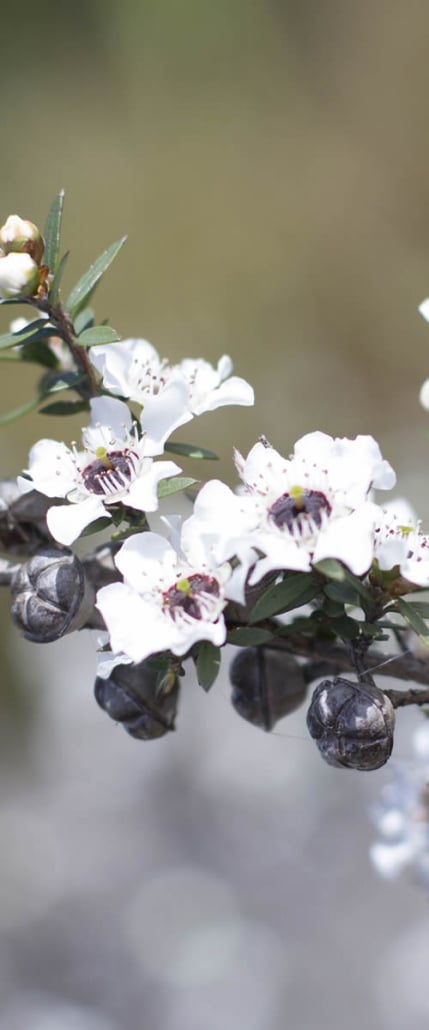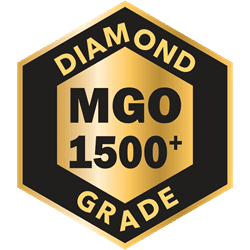At MNZ, we exclusively produce monofloral Manuka Honey sourced from the Leptospermum scoparium plant (ranging from small shrubs to large trees with blossoms) in the pristine landscapes of New Zealand.
Why Our Manuka Honey is Special:
- Remote Hive Locations:
Our beehives are located in one of the most remote areas of New Zealand, ensuring that the bees are not disturbed. This secluded environment allows the bees to thrive and produce high-quality Manuka Honey free from human interference. - High-Quality Production:
The natural surroundings contribute to the purity and bioactivity of our Manuka Honey, making it one of the finest products available in the market.
The Role of Methylglyoxal (MGO):
- Scientific Validation:
Methylglyoxal (MGO) is one of the most important compounds in Manuka Honey, known for its potent bioactive properties. Professor Thomas Henle has demonstrated the significance of MGO in contributing to the unique qualities of Manuka Honey. - Rigorous MGO Measurement:
The measurement of Methylglyoxal (MGO) is a science-based qualification and is one of the requirements set by the Ministry for Primary Industries (MPI) to ensure the authenticity and quality of Manuka Honey.
At MNZ, we combine the purity of New Zealand’s untouched environment with the latest scientific standards to deliver genuine, high-quality Manuka Honey that is scientifically verified for its natural bioactive properties.
Science
In 2006, Professor Thomas Henle made a groundbreaking discovery: he identified Methylglyoxal (MGO) as one of the key compounds in Manuka Honey, responsible for its high-quality bioactivity. Since then, Professor Henle has conducted extensive research into the properties of MGO and its significant role in the health benefits of Manuka Honey.
Why MGO Matters in Manuka Honey:
- Naturally Present Compound:
Methylglyoxal (MGO) is naturally present in Manuka Honey, and it is this compound that gives the honey its potent bioactive properties. - MGO Content:
The amount of MGO in Manuka Honey is measured in milligrams per kilogram (mg/kg). MGO levels can range from 100+ to 1500+ mg/kg, with higher levels indicating stronger bioactivity. - Key Indicator of Quality:
When purchasing Manuka Honey, MGO content is a very important factor to consider, as it directly impacts the quality and effectiveness of the honey.
For example, MGO 100+ indicates that the honey contains at least 100 mg/kg of Methylglyoxal, making it a reliable choice for its natural benefits.
At MNZ, we measure MGO accurately to ensure that our Manuka Honey consistently meets high standards of quality and bioactivity, providing you with a premium, natural product.
Scientific insight
Manuka Honey has been extensively researched by leading scientists who have contributed to understanding the unique qualities it possesses. Notable researchers include Professor Thomas Henle, Professor Peter Molan, Professor Keiji Terao, and Dr. Robert Laheij, each of whom has studied different aspects of Manuka Honey’s natural properties.
Key Findings on Methylglyoxal (MGO):
-
Professor Thomas Henle and Team:
Professor Henle’s research in 2006 identified Methylglyoxal (MGO) as a key compound responsible for the high-quality bioactivity of Manuka Honey. His team demonstrated that MGO is directly related to the potent antibacterial and bioactive properties that make Manuka Honey so unique and valuable. -
Professor Peter Molan:
Known for his pioneering work on Manuka Honey’s medical and therapeutic effects, Professor Molan’s research focused on how the honey’s natural compounds, including MGO, contribute to its healing properties. -
Other Researchers:
Professor Keiji Terao and Dr. Robert Laheij have also made valuable contributions to understanding the biochemical properties and health benefits of Manuka Honey.
The Role of MGO in Manuka Honey:
MGO is a naturally occurring compound in Manuka Honey and is a key marker of its bioactive properties. Higher MGO levels indicate stronger bioactivity, making MGO measurement a critical factor in evaluating the quality and effectiveness of Manuka Honey.
At MNZ, we stay committed to the scientific principles established by these researchers, ensuring that our Manuka Honey is consistently of the highest quality, with bioactive properties that are scientifically validated.
- Quote Thomas Henle
“A grading system must be scientifically sound, g based on a method that has been published, tested and can be used in laboratories, this is certainly the case for the Methylglyoxal (MGO) Manuka Honey classification “
Professor Thomas Henle of the Technical University of Dresden, who in 2006 showed that methylglyoxal as a compound is responsible for this special anti****** effect and thus characterises the properties of Manuka honey, also says that testing for methylglyoxal levels in Manuka honey is a reliable, quantitative method.
Professor Thomas Henle (discoverer MGO)
- Quote Peter Molan
“Testing for Methylglyoxal (MGO) is a clear and unambiguous way of letting consumers know that this unique high anti******* activity is real, special and exclusive to Manuka Honey.“
Professor Peter Molan (discoverer of the UMF value)
MGO (Methylglyoxal) as a scientific benchmark
Methylglyoxal (MGO) is one of the most crucial compounds in Manuka Honey, directly responsible for its potent bioactivity and therapeutic properties. The MGO content is an essential indicator of the quality and effectiveness of Manuka Honey. For example, MGO 550+ Manuka Honey contains at least 550 mg/kg of MGO, with higher MGO values reflecting stronger bioactivity and higher-quality honey.
Professor Peter Molan and His Groundbreaking Research:
-
Extensive Research on Manuka Honey:
Professor Peter Molan, based at the University of Waikato, dedicated much of his career to studying the unique qualities of Manuka Honey. He led the Waikato Honey Research Unit, a team of scientists focused on investigating the complex composition and bioactive properties of Manuka Honey. -
The UMF System:
In collaboration with the Active Manuka Honey Association (AMHA), Professor Molan developed the UMF (Unique Manuka Factor) grading system to standardize the production of Manuka Honey. This system helped classify Manuka Honey based on its bioactivity, which was initially thought to be an unexplained phenomenon. -
Discovery of UMF and MGO:
While Professor Molan recognized that Manuka Honey had a special effect—later termed UMF—he initially couldn’t identify the exact compound responsible for its bioactive properties. The discovery of Methylglyoxal (MGO) by Professor Thomas Henle in 2006 clarified the role of MGO in providing the therapeutic effects associated with Manuka Honey.
Professor Molan’s pioneering work laid the foundation for the scientific understanding of Manuka Honey, and his legacy continues to influence the way this exceptional honey is produced and evaluated today.
MGO and its bioactive properties remain at the heart of Manuka Honey’s appeal, and at MNZ, we uphold these standards to deliver the highest-quality, bioactive Manuka Honey to our customers.

MANUKA HONEY WITH MGO (METHYLGLYOXAL)
MNZ’s MGO 100+ Manuka Honey
contains a minimum of 100 mg/kg Methylgyloxal (MGO)

MNZ’s MGO 250+ Manuka Honey
contains a minimum of 250 mg/kg Methylgyloxal (MGO)

MNZ’s MGO 400+ Manuka Honey
contains a minimum of 400 mg/kg Methylgyloxal (MGO)

MNZ’s MGO 550+ Manuka Honey
contains a minimum of 550 mg/kg Methylgyloxal (MGO)

MNZ’s MGO 1000+ Manuka Honey
contains a minimum of 1000 mg/kg Methylgyloxal (MGO)

MNZ’s MGO 1200+ Manuka Honey
contains a minimum of 1200 mg/kg Methylgyloxal (MGO)

MNZ’s MGO 1500+ Manuka Honey
contains a minimum of 1500 mg/kg Methylgyloxal (MGO)

